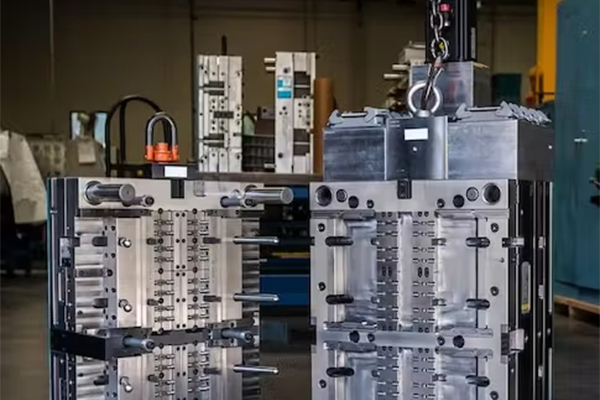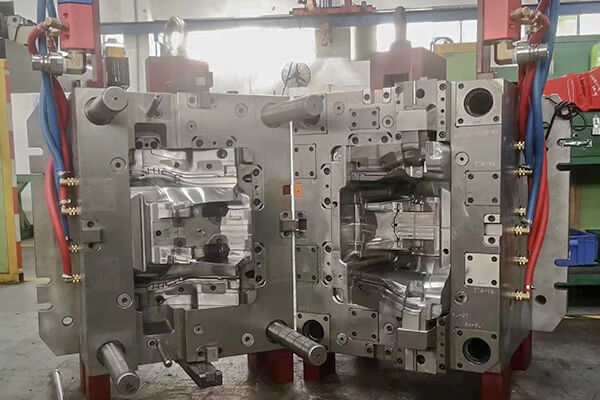Injection Molds 101: Cold Runner VS. Hot Runner Molds

What Is Cold Runner Molds?
Cold runner molds typically comprise two or three plates securely positioned within the mold base. Initially, the molten thermoplastic material is injected into the mold through a nozzle, entering via the sprue, and filling a network of unheated runners that lead to the mold cavities. These runners serve as a conveyance system, distributing the molten plastic to the individual molding cavities. As part of this process, the cold runner system also cools the sprue, runner, gate, and the molded part.
In two-plate molds, the sprue and runner system remain attached to the final product. An ejection mechanism is subsequently employed to separate the molded component from the core half of the mold. To draw an analogy, think of assembling a model car during your youth – the runners and parts were still connected, and it was the assembler’s responsibility to complete this final step.
In three-plate molds, a stripper plate holds the sprue, facilitating the delivery of molten thermoplastic to the network of runners, which are housed in a separate cavity plate. The final molded part takes shape and cools on the core half of the plate, devoid of any attached runners or gates. The three-plate mold system automatically detaches the runner from the part as the mold opens. In both two-plate and three-plate mold systems, the runner can be reprocessed and recycled, thus contributing to a reduction in plastic waste.
Advantages & Disadvantages of Cold Runner Molds
Cold runner molds are generally known for their cost-effectiveness when compared to their hot runner molds. This cost advantage stems from lower overall production costs and reduced maintenance expenses. Cold runners are versatile, accommodating a wide range of commodity and engineered thermoplastics. They also offer greater flexibility in terms of runner and gate placement, facilitating faster design adjustments.
However, a significant drawback of cold runner systems is the production of runners themselves. In two-plate cold runner systems, runners must be manually separated from the finished parts after each run. Unless these runners are recycled, plastic material is wasted after each cycle. Additionally, the removal of sprues and runners, as well as the time required for recycling, increases cycle times, resulting in slower production compared to hot runner mold systems.
What Is Hot Runner Molds?
Hot runner molds are composed of two plates heated through a manifold system. Hot runner manifold plays a crucial role in maintaining a uniform temperature by ensuring that the molten thermoplastic in the runners matches the temperature of the heating cylinder. The heated runners then transport the molten plastic to nozzles, which in turn fill the core mold to create the final part.
The heated runner system is situated within a separate plate, which remains stationary throughout the molding cycle. Subsequently, the core molding plate opens to reveal the final molded component, free from any attached runners.
Various types of hot runner systems exist, but they generally fall into two primary categories: externally heated and internally heated. Externally heated systems are particularly suitable for thermally sensitive polymers, while internally heated systems offer superior flow control.
The hot runner process completely eliminates the presence of runners, meaning that recycling and regrinding (usually feasible only with virgin plastics) do not affect cycle times. A variation of this system is referred to as an insulated runner. In this case, insulation, rather than heat, is used to maintain the plastic in a molten state. It’s worth noting that this system is compatible with only certain types of plastics, specifically semi-crystalline polymers characterized by low thermal conductivity.

Advantages & Disadvantages of Hot Runner Molds
Hot runner mold systems generally boast notably shorter cycle times than cold runner mold systems. The elimination of runners reduces post-production tasks such as runner and sprue removal, regrinding, and recycling. The absence of runners also minimizes potential waste during molding and eliminates the need for robotics to remove runners, leading to cost savings and increased automation efficiency.
Furthermore, hot runner mold systems can handle larger part sizes since each runner feeds a dedicated mold. However, hot runners tend to be more expensive than cold runner injection mold systems. Given that each hot runner feeds into a specific mold, additional internal or external heating sources are required to maintain consistent runner temperatures.
Additionally, hot runner mold systems typically have higher tooling costs compared to cold runner mold systems, making molded parts potentially more expensive to produce and increasing overall production costs. The intricate nature of hot runner mold equipment necessitates meticulous inspection and maintenance, leading to higher maintenance costs and potential downtime. It’s worth noting that internally heated hot runner mold systems may not be suitable for thermally sensitive polymers, as material adhesion and overheating can occur in certain areas.
Choosing the Right Plastic Mold Injection Technology
Sungplastic is a professional mold manufacturer, we have rich production experience and excellent professional knowledge. When providing you with excellent mold solutions, we insist on comprehensive consideration of various key factors to ensure the best productivity and cost-effectiveness for your project.
When choosing a cold runner mold or a hot runner mold, we should consider the following factors:
-
- Volume Requirements:
Cold runner molds are generally suitable for low to medium volumes, while hot runner molds are more suitable for high-volume production. - Cost Considerations:
Cold runner molds are generally more attractive in terms of initial investment, but may have some additional costs in terms of material waste and energy consumption. Hot runner molds have a higher initial cost but may be more economical in mass production because they reduce material waste and energy consumption. - Material Selection:
Some plastics are more sensitive to hot runner molds, while others are better suited to cold runner molds. Make sure the type of mold you choose is compatible with your material. - Part Size and Complexity:
Hot runner molds are generally better suited for manufacturing larger or complex parts because they provide better flow control. For smaller and simpler parts, cold runner molds may be sufficient. - DesignFlexibility:
If you need to frequently change part designs or adjust the parameters of your injection molding system, cold runner molds may be a better fit because they typically offer greater design flexibility. - Cycle Time:
Hot runner molds typically have shorter cycle times because they don’t have to deal with cooling channels.
- Volume Requirements:
When selecting mold technology, we recommend that you work with our professional engineers and we will provide you with customized recommendations to ensure the best results for your project. Whether it’s a cold runner mold or a hot runner mold, we will meet your production needs. Contact us today to start our cooperation.
Get a free quote and design analysis today.
We’ll reply to you within 6 working hours.
We respect your privacy.
+86 139 2927 4777 (WhatsApp, Wechat)
